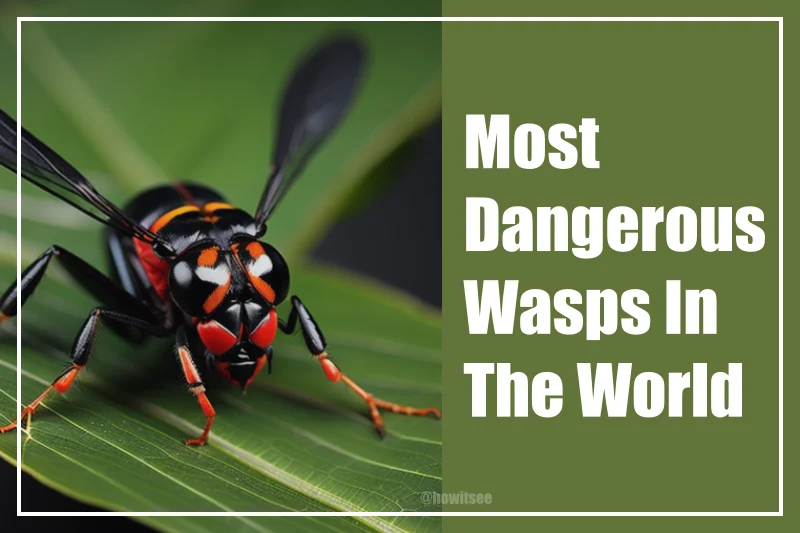Wasps, a common name among stinger insects, are often feared among people for their painful stings. These insects are primarily nectar feeders but may sometimes devour on other insects and spiders. Wasps have a wide distribution with a variety of colors and sizes, each with its intriguing characteristics. Among the spectrum of species, a common question that keeps surfacing is, Which are the deadliest ones? Therefore, in this article, we bring you the Top 6 Most Dangerous Wasps in the world.
Here’s What We Need to Know First
To our surprise, this insect under discussion (wasp) is often mistaken for bees and hornets. Numerous factors contribute to this, including their similarity in appearance, habitat, and nature. Consequently, to correctly identify them, we must first comprehend how they differ from each other.
So, let us start by understanding the key differences and similarities between bees, wasps, and hornets, and then we will rank which is the most dangerous one on our list.
What is The Difference Between Wasps, Bees & Hornets?
Let’s start by discussing the differences between wasps and bees and later move on to hornets.
Many people are aware of the fact that bees are the primary pollinators in our environment and that they have a fuzzy appearance. Additionally, while not all bees make honey, they do.
They are also the least agitated, going about their business mostly. But they will sting without restraint, even if it means killing themselves if they sense a threat from you. That’s correct! Bees only have one chance to sting, so when they do, it causes severe pain in the abdomen leading to death.
You should avoid wasps since they are irritable and aggressive. They sting repeatedly without any mercy.
Unlike bees, who want to live near flower fields, their food source, wasps prefer to make their nests in trees and shrubs near your homes. Plus, they are not fuzzy. Not a single hair! They are good pollinators, but neither of them produces honey, however, exceptions are always there.
On the flip side, hornets are essentially overblown wasps. Larger, giving away more painful stings due to their amplified venom. However, toxicity varies by species, and the severity of reaction post-bite varies among individuals.
Certain species of hornets can grow up to be as long as 5-5.5 cm. That is nearly twice as big as a giant wasp. The largest wasps have a maximum length of 2–2.5 cm. Moreover, both are larger than any species of bee.
In addition, hornets like to prey on insects smaller than themselves, so they occasionally eat wasps too.
What is Schmidt’s Pain Index?
An obvious question now emerges: how can we rank the potential danger of a species?
The solution is above in the title- Schmidt’s index. The Schmidt Sting Pain Index is a pain scale that assigns a number between 0 and 4 to each hymenopteran (a large order of insects that includes wasps, ants, bees, and sawflies) sting’s level of discomfort.
Stings with 0 denote no pain at all, and 4 signify extreme hurt. And we will solely use Schmidt’s index as our basis for ranking in this article.
List of 15 Most Dangerous Wasps, Bees & Hornets
15. Sonoran bumblebee
| Scientific Name | Apis mellifera |
| Size | 14-18mm |
| Schmidt’s Pain Index | 2 |
| Location | Sonoran desert and western US |
The huge, hairy Sonoran bumble bees range in length from 3/4 to 1 & and a half inches. They are beautiful black and yellow bees having hairy legs that they utilize to gather and carry pollen to the hive.
Its sting can cause a variety of reactions, from mild discomfort and pain to a severe allergic reaction. It explains why they are on point 2 on the pain scale.
14. Western Honeybee
| Scientific Name | Apis mellifera |
| Size | 10-20mm |
| Schmidt’s Pain Index | 2 |
| Location | Native to Africa and Europe |
Although honey bee stings are known to be extremely painful, the symptoms that follow a sting differ depending on how much venom has entered the victim’s body. After a while, the initial discomfort goes away, but not before swelling and itching.
However, these symptoms sound very normal to any insect bite so, it is not very dangerous but surely bothersome for a while.
13. European Hornet
| Scientific Name | Vespa crabro |
| Size | 1-1.3 inches |
| Schmidt’s Pain Index | 2 |
| Location | Europe and North America |
They are among the biggest wasps in the regions where they live, and because of their similar appearance, they are frequently mistaken for Asian giant hornets.
Among the most dangerous wasps existing, they for sure deserve one of the bottom ranks. Since their bite causes similar pain to a honeybee sting and casual symptoms like itching, redness, and painful swelling, they rank 2 on the pain scale.
12. Bald-Faced Hornets

| Scientific Name | Dolichovespula maculata |
| Size | 19 mm |
| Schmidt’s Pain Index | 2 |
| Location | the United States and southern Canada |
Bald-Faced Hornets, scientifically known as Dolichovespula maculata, are one of the deadliest species of wasps, with a pain level of 2 on Schmidt’s Pain Index. These are medium-sized wasps that can grow up to 19 mm.
They are brownish-black in color with white patterns all over the body, as shown in the image. Bald-faced hornets love to feed on soft-bodied insects, including caterpillars and aphids.
11. Asian Giant Hornet
| Scientific Name | Vespa mandarinia |
| Size | 1.5 to over 2 inches long |
| Schmidt’s Pain Index | 2 |
| Location | Native to Japan, widespread throughout Asia |
The invasive Asian giant hornets — also known as “murder hornets” — despite their ranking 2 on the pain scale, are definitely deadly if they sting someone multiple times.
The ranking is so because they cannot cause as much damage as the warrior wasps or executioner wasps credited to the toxins present in their venom. However, their bite doesn’t just go away in a few minutes and rather escalates.
10. Western Yellow Jacket
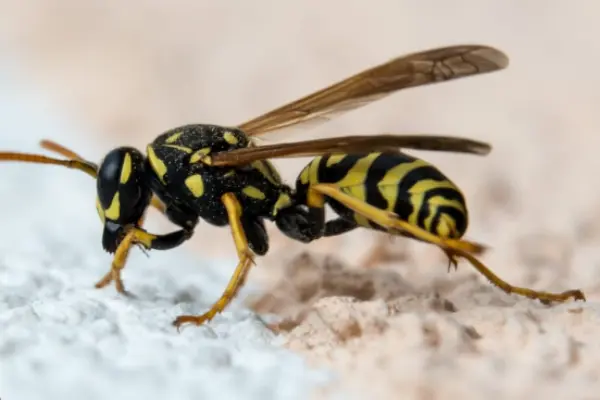
| Scientific Name | Vespula pensylvanica |
| Size | 15 mm |
| Schmidt’s Pain Index | 2.5 |
| Location | Northern Regions of America |
With a Pain Level of 2.5 on Schmidt’s Pain Index, the Western Yellow Jacket is one of the most dangerous wasps found in the Northern Regions of America.
They tend to sting repeatedly, causing immense pain. The pain is described as sudden, causing redness and swelling around the region. These wasps come in a size range of 0.4- 0.6 inches and are considered a pest in Hawaiian regions.
9. Fierce Black Polybia Wasp
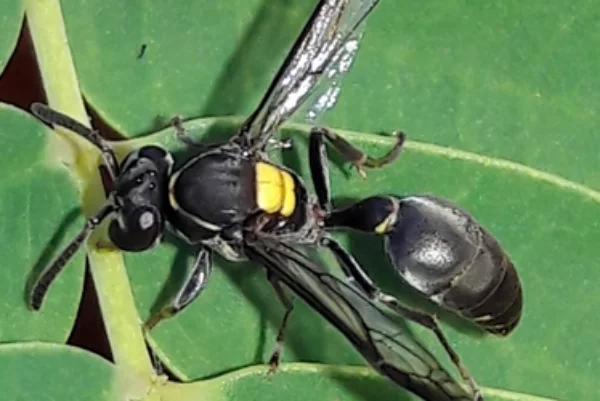
| Scientific Name | Polybia simillima |
| Size | 4.5 mm |
| Schmidt’s Pain Index | 2.5 |
| Location | Central America |
This fast-moving, buzzing insect is known to sting painfully. The fierce black polybia wasp (Polybia simillima) has a reputation for giving away a ‘spicy‘ to ‘shockingly electric‘ sting. Hence, they are ranked 2.5 on the pain scale.
Their small size must not be mistaken as they are quite ferocious in nature.
8. Black-Bellied Hornet
| Scientific Name | Vespa basalis |
| Size | small to mid-sized |
| Schmidt’s Pain Index | — |
| Location | Taiwan |
One of the most deadly hornet species in Taiwan is the black-bellied hornet (Vespa basalis), which can even cause edema with its venom. In China, this hornet species is to blame for several accidents and cases of severe wasp envenomation. Hence it is always advisable to stay away from them.
Though it is only moderately pugnacious, there have been multiple reports of attacks and severe reactions among people from a black-bellied hornet’s bite.
7. Red Paper Wasp
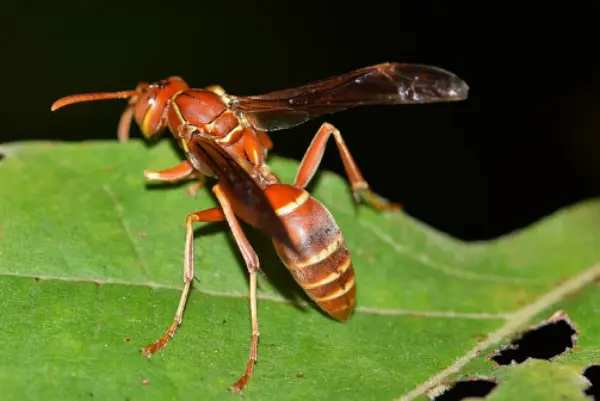
| Scientific Name | Polistes carolina |
| Size | 30 mm |
| Schmidt’s Pain Index | 3 |
| Location | Eastern United States |
Here is another paper wasp on our list of the Deadliest Wasp Species. With a rating of 3 on Schmidt’s Pain Index, the Red Paper Wasp’s sting is said to cause excruciating pain that can be compared to a drop of hot heated oil in hand.
With a body length of 0.9- 1.2 inches, they get their name from their distinctive red color. The pain from their sting may last up to 10 minutes or sometimes even more.
6. Giant Brown Paper Wasp
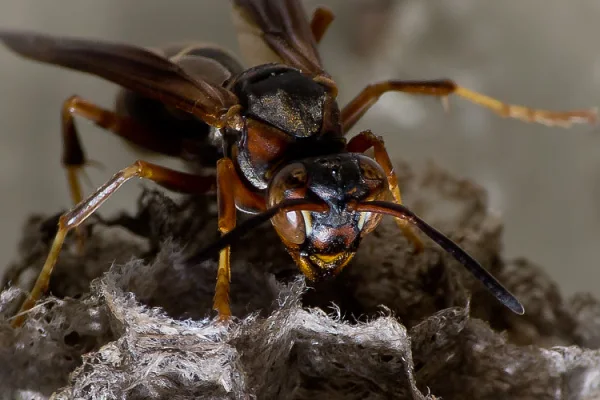
| Scientific Name | Polistes gigas |
| Size | Average 2.5-3.5cm (can grow up to 5cm in rare circumstances) |
| Schmidt’s Pain Index | 3 |
| Location | Native to South-East Asia, also widespread in North America |
This is a massive paper wasp, ranked 3 on the scale! We need to be afraid because stronger muscles translate into more capacity for damage.
A sting needle near its tail allows the giant brown paper wasp to sting humans. However, it is not aggressive and only sometimes attacks people when it feels a threat.
As a result, it should be handled carefully because getting stung will hurt a lot and resulting swelling and redness may last up to 8 hours.
5. Red-Headed Paper Wasp
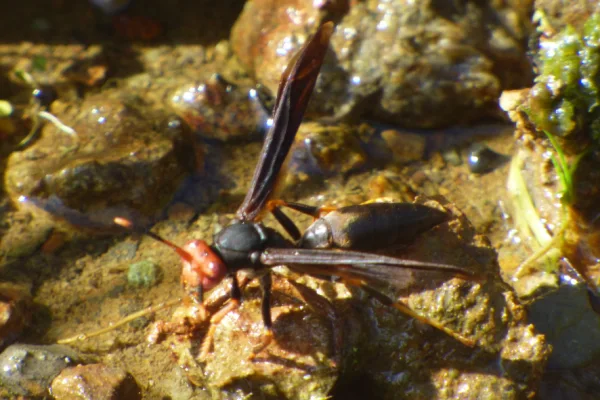
| Scientific Name | Polistes erythrocephalus |
| Size | about 2cm |
| Schmidt’s Pain Index | 3 |
| Location | Central & South America |
The Red-headed paper wasp, another wasp with a 3 on Schmidt’s pain scale, may sting humans with its sting needle at the tail. However, it is not violent and only sometimes attacks people when they feel scared. Its bite causes immediate, irrationally severe, and unceasing pain, according to witnesses.
With a traditional black body and an entirely flame-red head portion, its name entirely justifies its appearance.
4. Velvet Ant Wasp
| Scientific Name | Dasymutilla klugii |
| Size | as big as 2.5cm |
| Schmidt’s Pain Index | 3 |
| Location | Texas and Oklahoma |
Despite the name, it is a wasp species with females bearing no wings. On the Pain Scale Index, the infamous sting of the species velvet ant wasp ranks at 3.
To our surprise, the only things that can defeat it are the stings of bullet ants, tarantula hawks, and warrior wasps! Its impressive size explains its strength and danger, providing humans with every excuse not to halt their regular errands.
3. Executioner Wasp

| Scientific Name | Polistes carnifex |
| Size | 30 mm |
| Schmidt’s Pain Index | 3 |
| Location | South American Tropical Rainforest |
The third wasp on our list of the Most Dangerous Wasp is the Executioner Wasp. A sub-species of the deadly Paper Wasp, the Executioner Wasp has non-aggressive behavior but possesses an extremely potent sting. These wasps have an average length of around 30 mm.
The Executioner Wasp is known throughout South American Rainforests for its extremely painful sting, and the venom can cause tissue necrosis, resulting in the rotting of the tissues around the sting.
2. Warrior Wasp
| Genus | Synoeca septentrionalis |
| Size | ~20 millimeters |
| Schmidt’s Pain Index | 4 |
| Location | North as Mexico, throughout Central America, and northern South America |
Next up, we have another wasp species whose sting is extremely painful, with the pain being highly traumatizing. The sting of a Warrior Wasp bears a rating of 4 on Schmidt’s Pain Index.
The famous entomologist, Justin Schmidt, describes the pain to be “explosive and long-lasting.” These deadly bear a body length of 0.7 inches.
The sting of this wasp is most feared due to the immense pain it causes, while the venom is comparatively less toxic and a non-lethal one. The pain may last up to 2.5 hours, in some cases even up to a day.
1. Tarantula hawk Wasp
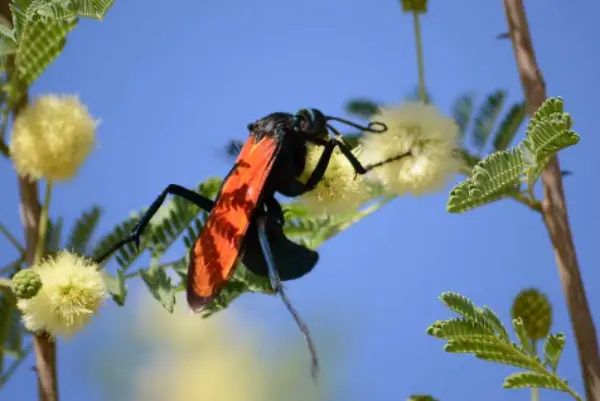
| Scientific name | Pepsis grossa |
| Size | up to 5 cm or more |
| Schmidt’s Pain Index | 4 |
| Location | across northern South America and southern USA, including the Caribbean |
On the first position on this list of the deadliest wasps on the planet, we have this Tarantula Wasp. Recognized for having one of the most poisonous and deadliest stings, this species of wasp gets its name from the prey they hunt, the great tarantula spiders.
Researchers describe the pain to be instantaneous, and electrifying and can make the body go numb in a few minutes. Measuring 5cm in length, with a rating of 4 on Schmidt’s Pain Index, the Tarantula Hawk Wasp is undoubtedly the most dangerous wasp.
Among all Tarantula hawk Wasps, Pepsis heros are the largest species that can grow up to 11 cm in length.
Other Tarantula hawk species:
- Pepsis thisbe
- Hemipepsis ustulata
- Pepsis heros
- Pepsis albocincta
- Pepsis pallidolimbata
- Pepsis marginata
- Pepsis menechma
- Pepsis ruficornis
- Hemipepsis tamisieri
- Hemipepsis heros
So, if in case you cross this living terror, make sure you leave it undisturbed.
Most Dangerous Wasps/Hornets (Reddit User Experience)
What are some of the most dangerous wasps/hornets?
by ininsects
According to the reddit post “What are some of the most dangerous wasps/hornets?” on the r/insects community, a user named u/FireStrike5 shared some of its significant knowledge to describe the most dangerous wasps.
Three noteworthy species in that post were (also included in our list) Tarantula hawk wasps, Vespa luctuosa, and Vespa mandarinia.
Vespa luctuosa possesses the deadliest venom of all those 3 wasp species, even though they are all rated at point 4 on the pain scale. But unlike other species, they do not inject as much venom, and as a result, they are not responsible for a large number of human deaths.
The murder hornet, Vespa mandarinia, on the other hand, is far more aggressive and has venom that is extremely toxic. Therefore, it won’t do any harm to award them the top rank on the list of the most dangerous wasps, which is instead given to the gentler tarantula hawk wasps with lesser toxic venom.
Most Dangerous Wasps/Hornets (Quora User Experience)
According to the research on quora, under the question “What is the biggest, scariest, and most powerful and dangerous wasps or hornet type bug?“, a few users shared their part of some significant knowledge to describe the most dangerous wasps.
Accordingly, an Asian giant hornet, vespa mandarinia, is the most aggressive species that kill around 40 people per year in Japan. And this number, for such a small insect, is really significant.
They deliver the venom through their 1/4-inch stingers that can dissolve human tissue. And only a few stings can be deadly. So, this species well deserves a high spot as one of the most fatal hornets.
It is also mentioned in the post that a bumblebee’s sting can cause considerable agony which cannot be put aside.
What Attracts Dangerous Wasps?
Dangerous wasps are attracted to various factors, including food sources such as sugary substances and human foods.
Additionally, some species are territorial and may become aggressive when they perceive a threat to their nests or colonies.
How to Prevent Wasp Stings?
To reduce the risk of getting stung by dangerous wasps, follow these preventive measures:
- Keep food and drinks covered when outdoors.
- Seal garbage cans and dispose of waste properly.
- Avoid swatting at wasps, as it may provoke them.
- Wear light-colored clothing, as dark colors can attract wasps.
- Conduct regular inspections around your property for wasp nests and have them removed professionally if necessary.
What to Do if You Get Stung?
- If you get stung by a wasp, here are some steps to take:
- Remain calm and slowly move away from the area to avoid further attacks.
- Remove the stinger, if present, by gently scraping it off with a credit card or your fingernail.
- Wash the sting area with soap and water.
- Apply a cold compress or ice pack to reduce swelling and pain.
- Use over-the-counter antihistamines or pain relievers if necessary.
- Seek medical attention if you experience severe symptoms or have a known allergy to wasp stings.
Here we come to the end of our article on the Top 5 Most Dangerous Wasp Species. We will be back with more informative articles, so stay tuned until then.
FAQs
Q1. What is the most dangerous wasp in North America?
Ans. The most dangerous wasps in North America are the yellow jackets as they are the most prevalent and aggressive wasps there.
Q2. What is the scariest wasp in the world?
Ans. The tarantula hawk which is on the top of our list is by far the scariest wasp species in the world that causes the most damage.
Q3. What wasps are dangerous to humans?
Ans. Many wasps are known for their random attacks and can pose a threat to people. So, it is obvious that they are dangerous to humans. Some of the most dangerous wasps are the tarantula hawks, warrior wasps, paper wasps, etc.
Q4. What is the deadliest hornet?
Ans. Murder hornets, which are native to East Asia, as their name depicts, are the deadliest hornets. Their multiple sting can cause death among people while a single sting may cause severe discomfort and pain.
Q5. What is the king of wasp?
Ans. Megalara garuda, aka the “King of Wasps,” is the sole species of giant wasp in its genus within the Crabronidae family. It is only known from the Mekongga Mountains in the southeastern part of the Indonesian island of Sulawesi.
Q6. Do killer wasps exist?
Ans. The answer is an absolute yes! Wasps are very well capable of even killing humans. And our list of the most dangerous wasps includes some of those killer wasps.
Q7. Which wasps chase you?
Ans. The yellow-jacket wasps are known to chase people. This is due to their instinct to protect their nests.
Q8. Do wasps want revenge?
Ans. It has been proven that wasps would join together to protect their colony and territory, even though there is no scientific evidence to support the theory that they genuinely seek revenge.
Q9. What is the most aggressive bee?
Ans. The answer is- Africanized “Killer” Bees. Compared to its European honeybee cousin, this kind of bee is far more aggressive. The threat stems from the fact that “killer” bees attack in far greater numbers—typically the entire colony—despite the fact that their venom is no more potent than that of a typical honeybee.
Also Read:

Anjali Prasad, a B. Pharm. graduate who works as a content writer for HowItSee, is based in Delhi. Except for her, not many people take the typical road from healthcare to writing. Her love of writing stemmed from her involvement in the college literature society and her early journaling at the age of 7. Hence, the love of learning and the spirit of exploration are what drew her to this career. You can find her on common social media like Instagram.
